Konigsberg Fall
On the evening of April 7th, Vasilevsky arrived at the command post of the 11th Guards Army in Shenmore. Having studied the situation, he decided to transfer the main efforts of the army to the left flank, developing an offensive on Amalienau. The divisions of the army of Galitsky were to force the river. Pregel and deliver a powerful blow towards the 43rd Army in order to surround the Konigsberg garrison, cutting it off from the main forces of the Zemland group. In the future, they planned to widen the gap between the Königsberg and Zemland groups, to finish off the Königsberg garrison. The 11th Guards Army was to be supported by the main forces aviation front.
Meanwhile, the German command made desperate efforts to strengthen the defense of the city. The units that opposed the 11-th Guards and 43-th army, were strengthened. To this end, part of the troops, who held defenses on calm front areas in the eastern and north-eastern sectors of the defense of the fortress, transferred to the southern part of the city and to the Amalienau area. Thus, the main forces of the 61 Infantry Division were transferred to the line of defense along the Pregel River. The line of defense on the Pregel River consisted of strong points and was saturated with a large number of firing points.
On the night of April 8, fighting continued. Soviet aircraft at night made about 1800 sorties, dropping 569 tons of bombs to the enemy. From the fire of Soviet artillery and air strikes, the central areas of the city were destroyed. Over Königsberg stood thick, impenetrable clouds of smoke and dust.
The right-flank 8-th Guards Corps conducted an operation to eliminate the German forces cut off in the Adel Neyendorf-Seligenfeld-Schönflies area. By morning, the Yeruzalem district was occupied, and enemy soldiers and officers were taken prisoner near 600. At night, the 83 Guards Division unsuccessfully tried several times to force the Alter Pregel River in the Rosenau area at night.
The 16-th Guards Rifle Corps, which was advancing in the center, continued to conduct stubborn battles with the enemy, breaking through the third position of the German garrison defense. As a result, the regiments of the 11 and 31 divisions of N. G. Tsyganov and I. D. Burmakov broke through the enemy defenses, reached the river in the morning, and immediately began to force it. The 95 th regiment of Colonel P. A. Leshchenko. The 31 th Guards Division was able to bypass the enemy fortifications and a swift attack seized the western railway bridge over the Pregel. The seizure of the most important crossing played an important role in the development of further offensive. Soviet troops began crossing.
The left-flank 36 th Guards Rifle Corps cleared the southern bank of the Pregel River from the Nazis and the troops of the 16 Division Major General M. A. Pronin began to force a water barrier on the move. Despite the strong barrage of enemy fire, the assault detachments of the 46 and 49 regiments captured the bridgeheads. The Germans counterattacked and managed to knock out a detachment of the 49 regiment on the southern coast. However, the assault squad 46-th regiment resisted. With the help of amphibians on the bridgehead threw reinforcements. Soviet attack aircraft destroyed the enemy's 8 rocket launchers, and German infantry was pushed to the ground by cannon fire. Taking advantage of the temporary confusion of the enemy, the troops of the division forced the river. The 16 Division began breaking through at Ratshof. In the morning, completing the rout of the enemy’s forces north of Nasser Garten, the river was forced also by units of General G. I. Karizhsky's 18 Division. 18-I Guards Rifle Division began to advance in the direction of Amalienau. In the second echelon she was followed by the 84-I Guards Division.
A correspondent of Pravda newspaper who was in the ranks of the Guards Army described the crossing of the Soviet Guards: “The Guard of General Galitsky forced the Pregel in total darkness. Direct-fire cannons, a lot of machine guns beat from the right bank of the Pregel to the left. Embankments were engulfed in fire, as if a stone suddenly caught fire. Collapsing, cracking buildings. And below, under a shower of shells and bullets, guardsmen of Colonel Tolstikov floated on the dark rapids of a wide river. They used everything that could stay in the water: rafts, barrels, logs, boats, amphibians, huge cylinders filled with air, swayed on the crests of the river boiling from the gaps. On the rafts floated guns.
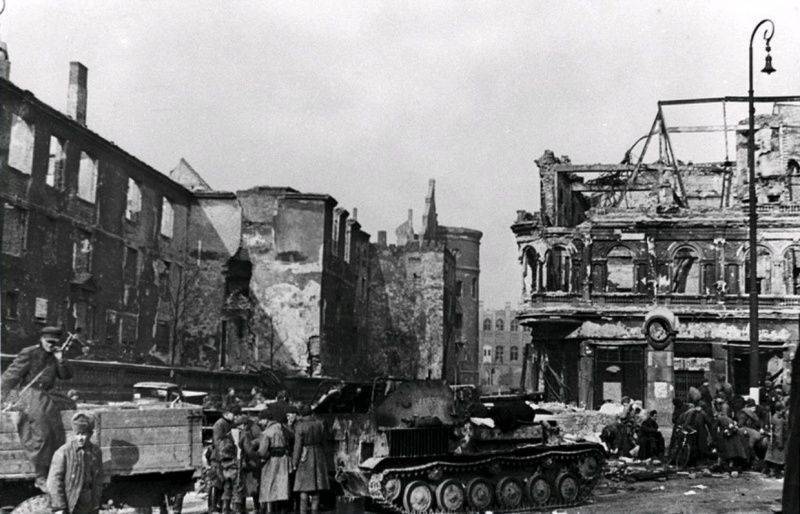
Soviet soldiers near the SU-76 self-propelled artillery installation in Konigsberg after fighting for the city
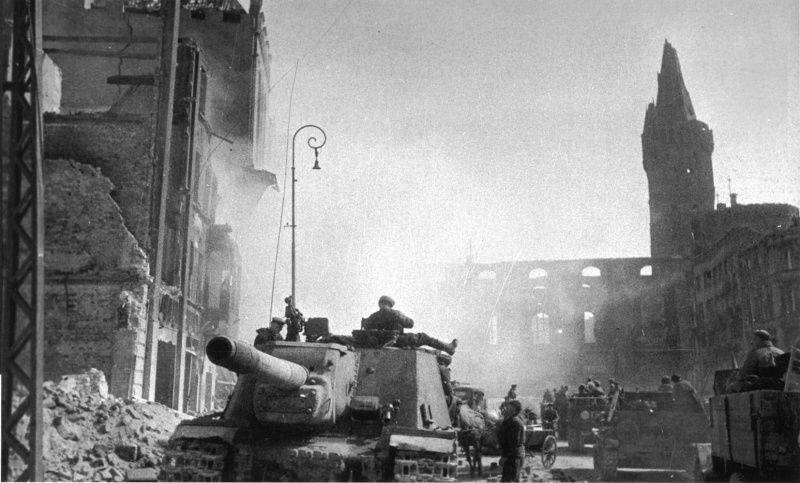
Soviet SAU ISU-152 "Hypericum" on the street taken by Koenigsberg
On the morning of April 8, heavy fighting for Koenigsberg continued. In the morning, Vasilevsky offered to capitulate to the German garrison, but did not receive a positive response. The left flank of the 11-th Guards Army broke through to join the 43-th army, and the divisions of the center and right flank waged heavy street battles, storming the quarter after quarter. At the same time, the 2-I Guards and 5-th army fought on the Zemland direction, holding down the 4-German army.
K 13 hour. The guardsmen took the area of Kosie south of Amalienau and the Pregel railway station. The Germans resisted stubbornly, tried to counterattack, but were driven back to the north. The commanders Galitsky and Beloborodov, in order not to inflict damage on each other with "friendly fire", agreed to cease artillery fire and airstrikes in the western regions, defeating the last pockets of German resistance in close combat. In 14 hour. parts of the two armies united: the troops of the 18 Guards Division met with parts of the 87 Guards Division in the Amalienau area, and the 16-I Guards Division with the 24 Guards Division of the 43 Army in the Ratshof area. As a result, the Königsberg garrison was surrounded from the west. The troops of the Galician and Beloborodov armies immediately expanded the encirclement zone. At the same time, Soviet troops continued the operation to dismember and destroy the garrison of the Konigsberg fortress.
The strikes of the Soviet aviation reached its maximum on this day. One after another, groups of bombers and attack aircraft brought down their deadly cargo on the Germans. Stormtroopers ironed enemy positions, suppressed their firing points. Thus, in the area of the Pregel railway station, there were up to three enemy artillery batteries, which held back the advance of our infantry. Shoot down the German gunners did not work. A group of six Il-2 senior lieutenant I. Ya. Belyakova dropped bombs on batteries, and then shot the calculations from machine guns and cannons. German position was destroyed. Within 24 hours, front-line aviation made more than 6 thousand sorties, dropping more than 2 thousand tons of bombs on the enemy.
In the afternoon, the Soviet troops continued the offensive. On the left flank and in the center of the 11 corps of the Guards Army, the main forces forced the River Pregel. The Germans still fiercely resisted, but by the evening more and more often they began to surrender. On the right flank, the 8 Corps has not yet been able to fully penetrate the river and force it. In the morning, the frontal attacks of the strong fortifications of the enemy in third position did not lead to success. Then the commander of the 8 Guards Corps, Lieutenant General M. N. Zavadovsky, regrouped the forces on the flanks. The 83 Division was supposed to advance north-west along the coast of Alter Pregel in order to reach the r. Pregel in the area east of the island on the river and force it. The 26 and 5 divisions with the support of artillery (the corps was sent to help the forces of the army artillery group) and aviation had to break through the third position of the enemy and get out on the river south of the island. After a serious artillery and aviation training, the troops of the 8 Corps broke through the enemy’s third position and began fighting for the quarters of the southeastern part of Königsberg.
The assault troops operated by similar methods: the tank moved ahead, firing at the firing points of the enemy, followed by self-propelled guns, supporting the tank with fire; with tanks sappers walked, clearing passages and blockages; around the line of the tank there were arrows, clinging to the walls of buildings, if necessary, they fired at opposing buildings, fired at enemy soldiers in window and doorways, balconies and attics, watched entrance doors, porches and basements; behind the arrows, fastening groups and flamethrowers moved to clear the territory. Meeting the stubborn resistance of the Germans, the defense unit, the assault group deployed guns: 45-mm cannons and regimental guns smashed the enemy firing points in buildings, hit the rubble and barricades; divisional guns crushed the lower floors with armor-piercing shells, creating breaks; guns of powerful calibers rained down the upper floors, "lowering" the Germans down. The artillery strike lasted 5-10 minutes, at which time the infantry was getting close to the distance of the assault throw. If necessary, called attack aircraft, which extinguished enemy firing positions.
Soviet soldier in the German Sdkfz 250 armored personnel carrier on one of the streets of Koenigsberg. April 1945
Soviet soldiers sleep, resting after battles, right on the street taken by assault of Koenigsberg
Results of the day
Thus, 8 on April 11-I Guards Army advanced a kilometer 2-3 and completely cleared the southern part of Konigsberg from the Nazis. The German 69 Infantry Division, defending in the southern part of the city, was defeated. The right flank of the army broke through the third position of the enemy and reached the south bank of the r. Alter Pregel and r. Pregel. The left flank and the center of the army broke through the r. Pregel. The left flank of the 11 Guards Army was combined with units of the 43 Army. The corridor between the Königsberg garrison and the 4 Army was expanded to 5 km. Fights have already gone for the city center. Königsberg garrison was surrounded and doomed to destruction. Front fights significantly reduced. The Germans kept only the center and the eastern part of Königsberg.
Soviet troops by the end of April 8 liberated 300 neighborhoods of the city. In the urban battles, the battalion of the 366 th rifle regiment of the 126 th rifle division of the 43 th army was especially notable. Combat Major Nikolai Mamontov personally led the assault groups. Under his command, the battalion fighters stormed a number of fortified buildings, cleared the Germans of the 23 quarter, destroyed about 450, and captured about 3 thousands of enemy soldiers and officers, freed 2 thousands of Soviet citizens. In addition, 6 guns, 300 vehicles, 160 carts with cargo, 6 warehouses with weapons and other trophies. By decree of the Presidium of the Supreme Soviet of the USSR from 19 April 1945, Major Nikolai Mamontov was awarded the high title of Hero of the Soviet Union. Many soldiers and officers were awarded orders and medals.
Bravely fought a sapper platoon of the 51-th separate sapper battalion of the 13-th Guards Rifle Corps under the command of Junior Lieutenant Alexander Mikhailovich Roditelev. On April 7, as part of an assault group, along with eight sappers, Parents broke into the enemy’s artillery positions, where there were 15 German guns. Soviet soldiers destroyed artillery calculations. Parents personally in hand-to-hand combat killed six (!) Nazis. The Germans could not stand the onslaught, 25 people surrendered, the rest fled. Then the Soviet soldiers fought off three German attacks. Heroic sappers held positions until the approach of their infantry. In this battle, the Soviet assault group under the leadership of Roditelev destroyed about Germans 40 and captured 15 (!) Serviceable heavy guns. Captured guns were used to fight the Germans. The next day, on April 8, Roditelev's group (13 fighters together with the commander) destroyed the enemy bunker and stormed 6 quarters of Königsberg. This is simply amazing: the indestructible squad of Roditelev from 13 man captured the enemy soldiers 200 that day! Just ready story for the heroic film about the Great Patriotic War. However, our (or not ours?) "Creators" prefer to make handicrafts about the "bloody fighters of the NKVD", "the tyranny of Stalin" and "the terrible crimes of the Soviet regime." 19 April 1945, the junior lieutenant Alexander Mikhailovich Roditelev, was awarded the title Hero of the Soviet Union.
Among the heroes who took Konigsberg was Zoya Kosmodemyanskaya's brother - Alexander Anatolevich Kosmodemyansky. The senior lieutenant commanded the XUUM-152 350-th Guards Heavy Self-Propelled Artillery Regiment Battery. This regiment fought in the offensive zone of the 319 th rifle division of the 43 th army. On April 6 in the district of Tranquitz Kosmodemyansky organized the guidance of crossings over the Land-Graben canal with a width of 30 meters and was the first to cross the water barrier. 8 April, his battery, despite the strong barrage of enemy fire and minefields, broke through to the fort "Queen Louise". Self-propelled gunners fired a volley around the fort, knocked out the gates and immediately broke into the fortifications. The Germans capitulated. 350 people were captured, 9 tanks captured, 200 vehicles and stock depots captured. Unfortunately, on April 13 during the battles on the Zemland peninsula, Alexander died the death of the brave. By decree of the Presidium of the Supreme Soviet of the USSR from 29 June 1945, Alexander Anatolyevich Kosmodemyansky was awarded the title Hero of the Soviet Union.
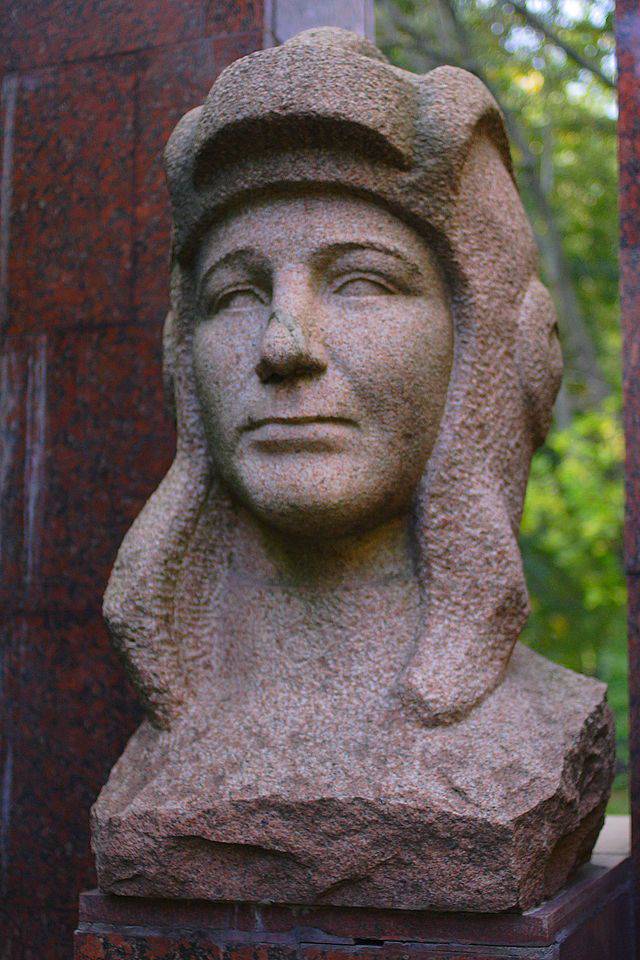
Monument to A. Kosmodemyansky at school. Zoya and Alexandra Kosmodemyansky in Moscow
9 April. Defeat the enemy
In the current situation, when the defeat was evident, the commander of the garrison of Lyash fortress once again asked the commander of the 4 Army Muller for permission to break out of the city. In his opinion, the situation was hopeless. The city could no longer be defended. Soviet troops in a number of places broke through to the center of the city, as a result of artillery, mortar and air strikes, the center of Königsberg was in ruins, and there were strong fires. Internal transport did not work, the supply of ammunition stopped, many stocks were destroyed, the communication lines were interrupted. The troops suffered heavy losses, their morale was suppressed. However, the command of the 4 Army again ordered all forces to defend themselves. Allowed to organize a breakthrough only a group of party leaders. They planned to strike the blow to the west. The outer ring of the environment had to break into the 5-I tank and 561-I infantry divisions.
The command of the 3 Belorussian Front decided on 9 of April to complete the rout of the enemy in Konigsberg. To continue the urban battles were mainly forces 11-th Guards and 50-th armies, 43-th army turned to the west to increase the pressure on the enemy's Zemland group. In this case, the Soviet command took into account that the concentration of enemy troops remained high and the enemy relies on powerful fortifications. The main effort to complete the operation was to be carried out by the 11 Guards Army. The right-flank 8 Guards Corps was to force the two arms of the r. Pregel (Neuer-Pregel, Alter Pregel) and advance to the northeast; the 16 Corps, located in the center, to continue the offensive straight north to Calthof; the left-flank 36 corps, in conjunction with the 54 corps of the 43 army, move from west to east in the direction of the Ober-Teih pond.
During this period, the workload of the rear services sharply increased, they needed not only to meet the needs of the army, but also to heal and feed the prisoners, whose number grew every day. Take care of the civilian population of Königsberg. Thousands of women, children and elderly people were hiding in the basements. They could not be left to fend for themselves. It was not in the Russian character. In each captured and destroyed quarter, bewildered, depressed and hungry people needed bread, and Soviet soldiers showed humanity and compassion. The rear services began organizing assistance to the civilian population. A huge role was played by the health service. During the assault on Königsberg, almost all of the wounded had to be removed from the battlefield. Basically it was done by first aid, girl nurses. Sometimes they literally had to carry the wounded for miles.
At night, the 8 Guards Corps, without prior preparation, immediately forced two branches of the Pregel River and captured the bridgeheads. In the morning, the guards fought in the eastern part of the city. Following the first echelon of the corps, the 26 and 5 divisions, the second echelon, the 83 division, began to cross. On the left flank of the army, the 18-I Guards Division withstood the blow of an enemy group that was trying to escape from the city. Then the 18 Division, supported by the troops of the 84 Division, went on the offensive, continuing to push the enemy. At the same time, heavy battles were fought in the offensive zone of the 13 Guards Rifle Corps of the 43 Army. Here a group of security and police units attempted to break through to the west. However, all German attacks were repelled. The strikes of the 5 Tank Division of the 4 of the German army on the outer ring of the encirclement were also repulsed. Parts of the 43 and 39 armies repelled all enemy attacks. The troops of the Zemland group could not break through to Konigsberg. Thus, the attempt to break the night out of the city failed. Only a few small groups could leave Königsberg.
Despite the desperate resistance, the situation for the German garrison worsened by the hour. The breakthrough failed, a blow from the outside to unlock Königsberg also failed. Soviet divisions took quarter by quarter, position by position. By 17, the 8 division of the Guards Corps captured neighborhoods on the eastern edge of the city. The German troops, who defended the left flank of the 50 Army, fearing complete isolation from the main forces of the garrison, retreated. Parts of the 50 Army advanced to the line east of the Ober-Teih-Kalthof-Zakheimer Ausbau pond, freeing those areas where the 8-Corps of the 11-Guards Army had to go in the evening.
The divisions of the 36 Corps, advancing from the west, broke through the enemy's internal defensive position and captured the northern passenger railway station. In 13 hour. The 1 Guards Division of the 16 Corps launched an attack on the Royal Castle. The former residence of the Prussian kings defended by special teams of officers and Nazis. However, the assault detachments of the division, with the support of guns set for direct fire, tanks and sapper units, broke into the interior. For several hours a stubborn battle lasted inside the castle, on the premises, on the floors and in separate buildings. K 19 hour. Royal castle taken. Meanwhile, the guards seized the building of the main post office and the main telegraph. The Il-2 attack aircraft groups, despite the complexity of the actions in a dilapidated city, where people and other people could fight in the same building on different floors, continued to provide support to the Soviet troops.
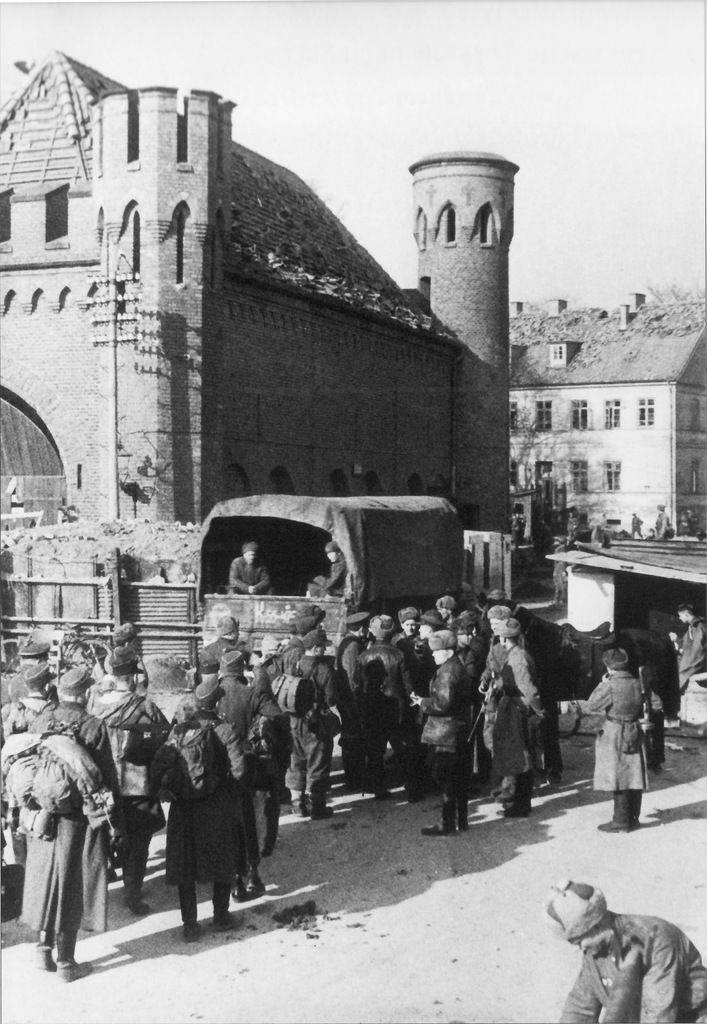
German prisoners at the Zackheim Gate Koenigsberg
Soviet soldiers in the German 150-mm sIG 33 infantry howitzers on Steile Strasse in Königsberg. 13.04.1945
The German fighter of tanks Jagdpanzer IV / 70 (left) and the semi-tracked Sd.Kfz.7 tractor on Königsberg street, attacked by Soviet troops during the assault. April 1945
Surrender
In the afternoon, the enemy's resistance began to weaken. In some areas, the Germans began to surrender in an organized, whole unit. K 19 hour. The 8 Corps of the 11 Guards Army was combined with the troops of the 50 Army. 8-th Guards Corps turned to the west. The 16 Corps fought in the city center and approached the Lyash command post. Parts of the 36 Corps also fought in the central part of the city. At 19 hour. 45 min. the last decisive assault was appointed. Assault detachments were preparing for the last spurt. Pulling up artillery, "Katyushas", self-propelled guns and tanks. German troops (about 40 thousand people) occupied a small part of the city west of the pond Schloss-Teich, having lost all defensive lines and without any hope. Commander Lyash noted: “There was not the slightest hope of changing the stalemate by waiting or continuing resistance ...”. Lyash and his commanders held a meeting and decided to capitulate.
Lyash expelled trucking. In 19 hour. the Germans asked to stop fighting. The Soviet command ceased fire, suspended the preparation of an assault, and sent Lyash to demand complete surrender. At the same time, Soviet troops were fully prepared to deliver a powerful blow if this was a hoax. The Germans had to surrender, all generals officers and soldiers were guaranteed life, security and return to their homeland, kept in shape, personal belongings and values. Wounded and sick were promised medical assistance. Lyash unconditionally accepted the ultimatum and 22 hour. 45 min. 9 April 1945 ordered the immediate cessation of resistance and surrender.
However, the fire in some areas continued, some German units continued to resist. Some German units, like the battalions of the Volkshturm, SS, who did not obey the commandant of the fortress, refused to surrender. In addition, there was no connection with part of the troops, and they continued to fight. The Soviet representative, Lieutenant Colonel P. G. Yanovsky, again went to Lyash with the proposal to immediately come to us with the whole headquarters. Lyash hesitated, but fearing that he and the supporters of the surrender would be shot by the SS, agreed. At midnight, the commandant of the fortress Königsberg Lyash and his headquarters (two generals and more 2 senior commanders) arrived at the headquarters of the 10 Guards Division. On the radio, they transmitted an appeal from Lyash for immediate surrender. At the same time, they printed and distributed leaflets urging German troops to cease resistance. From that moment on, the Germans became a large group, together with the officers, to surrender. Separate subdivisions still resisted, but by the morning of April 11, on the whole, the city was cleared of the Nazis.
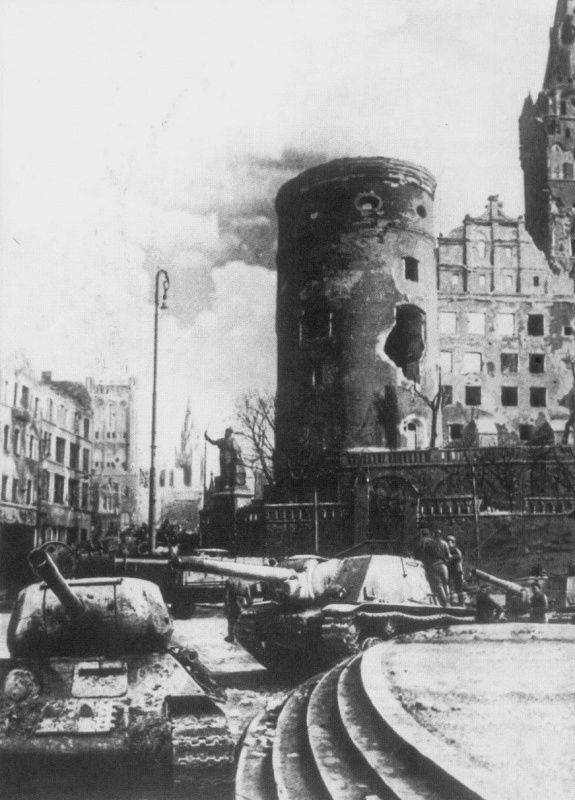
Soviet ACS ISU-152 and tank T-34-85 at Königsberg castle and monument to Kaiser Wilhelm I

Destroyed as a result of the storming of the city of the Royal Castle in Konigsberg
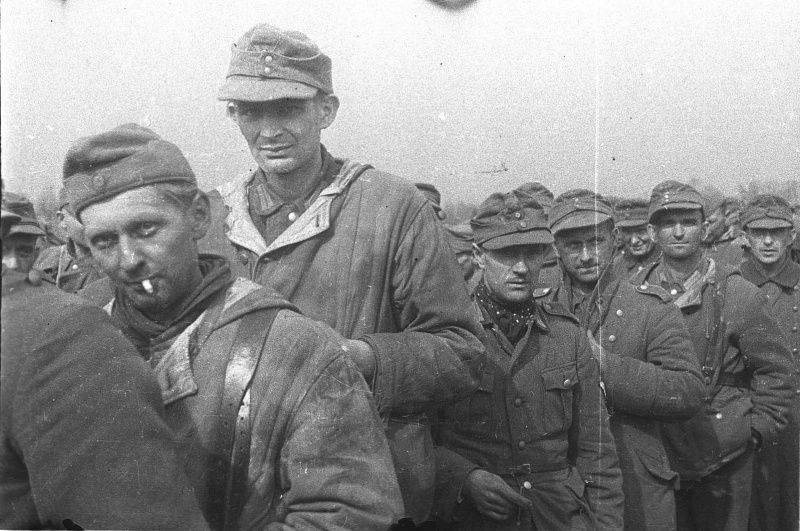
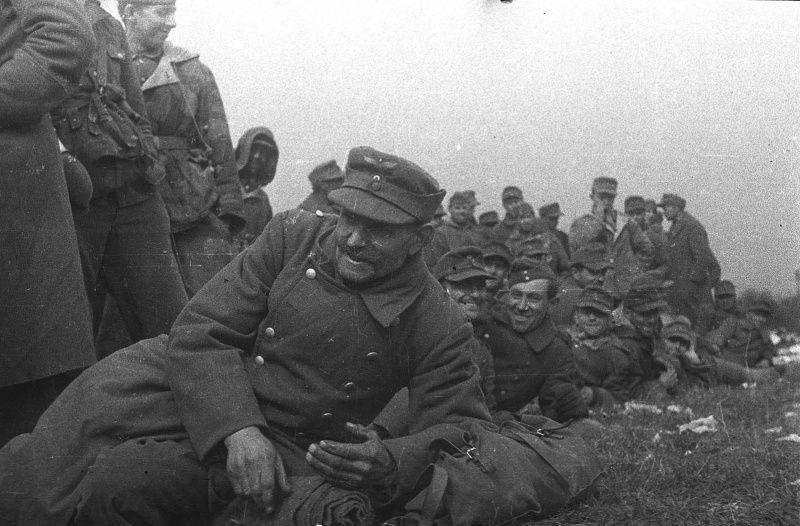
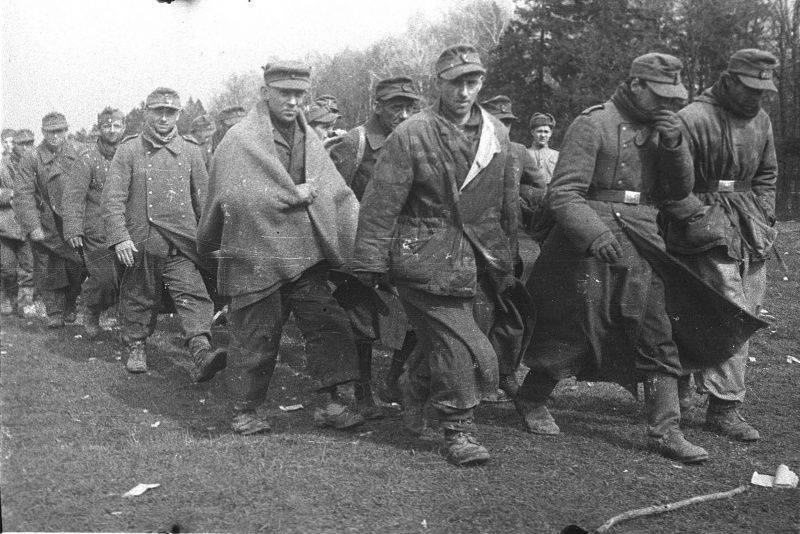
German soldiers captured during the assault of Koenigsberg
Results
The fortress city (actually a whole fortified area) Königsberg after a stubborn four-day battle by the forces of the troops 43, 50 and 11 of the Guards armies was taken. 2-I Guards, 5-I and 39-I armies played a supporting role in the battle, putting pressure on the Zemland group. It was a great success of the Red Army. The most powerful fortified with a huge 130-th. the garrison was taken in the shortest possible time and with forces approximately equal in number to the enemy. The Red Army troops broke through three enemy defense belts, surrounded Konigsberg and destroyed or captured the entire enemy garrison. During the assault, about 42 were killed by thousands of Germans, and about 93 thousands of soldiers and officers were captured. More than 3,5 thousand guns and mortars, around 130 aircraft and around 90 tanks and SPGs were captured as trophies. Only the troops of the 11 Guards Army captured more than 57 thousand Germans, captured around 2 thousand guns and mortars, more than 2,3 thousand machine guns, 44 tank and SAU, a large number of various vehicles, locomotives, wagons, river vessels as trophies etc. During the assault of Königsberg, more than 15 thousand prisoners of war of various nationalities were released.
Germany lost its most important fortress and historical center of state. The loss of Konigsberg became a strong moral blow for the Germans. Hitler for the surrender of the fortress in absentia sentenced Lyash and his family to death. The main forces of the East Prussian group were defeated. It remains only to defeat the Zemland group. This significantly weakened the forces of the Wehrmacht, worsened the overall operational and strategic position of the Third Reich on the Eastern Front. Germany lost important naval bases, and the supply of the Courland group worsened.
In Moscow, this victory was marked with the highest category salute - 324 guns made 24 artillery salvoes. 98 parts received the honorary title "Königsberg". Near 200 warriors were awarded the title Hero of the Soviet Union.
The capture of Königsberg created favorable conditions for the final elimination of the remnants of the East Prussian grouping (the Zemland Task Force) on the Zemland Peninsula.
Monument to soldiers of the 11 Guards Army, who died during the assault of Koenigsberg - Monument 1200 to the guardsmen. Opened in September 1945. The initiative to create the monument belonged to the Military Council of the 11 Guards Army, commanded by Colonel-General K. N. Galitsky.
To be continued ...
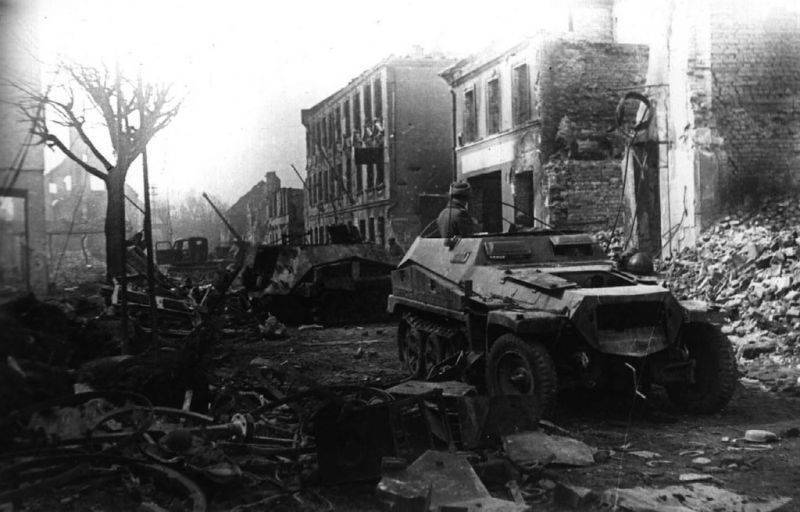
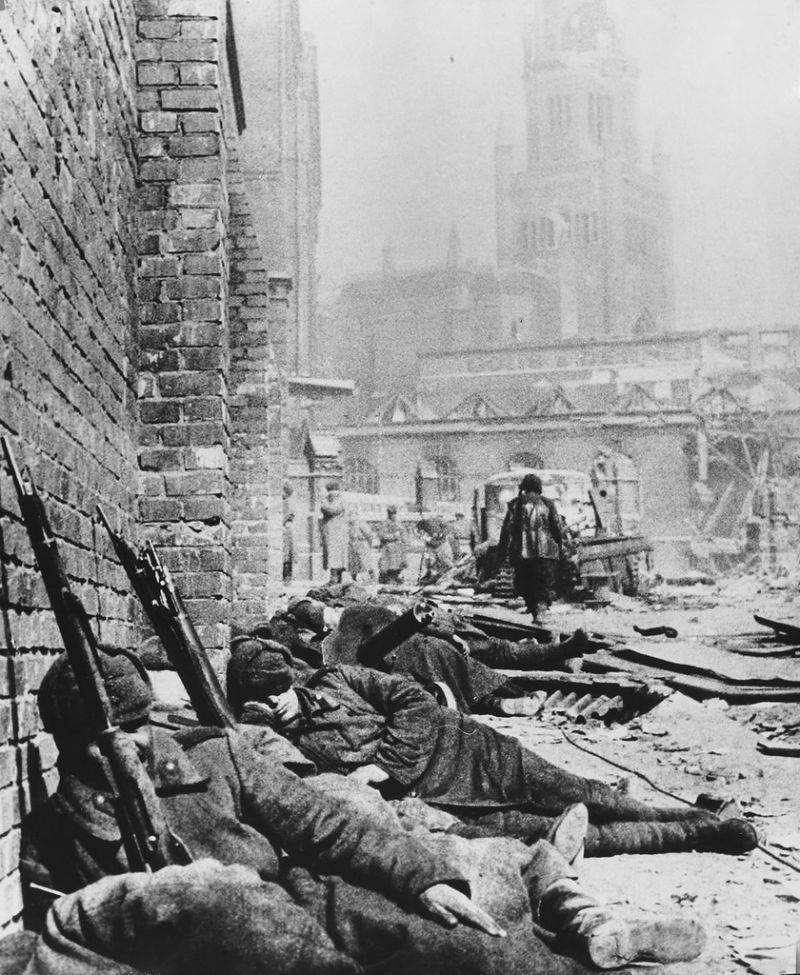
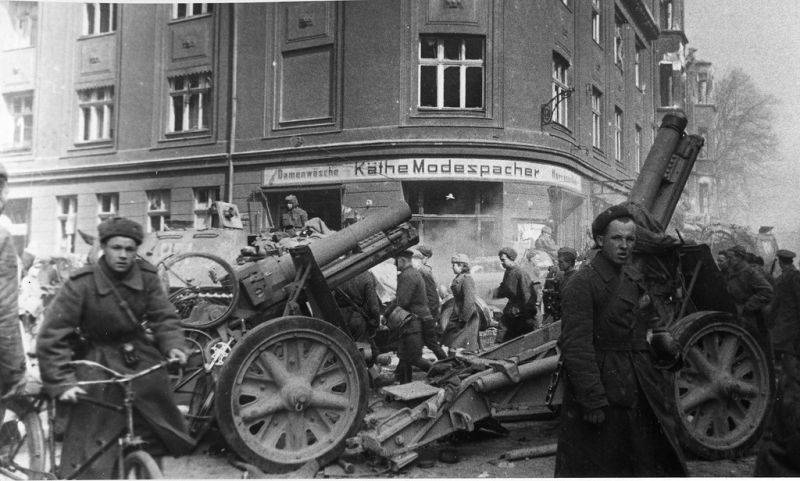
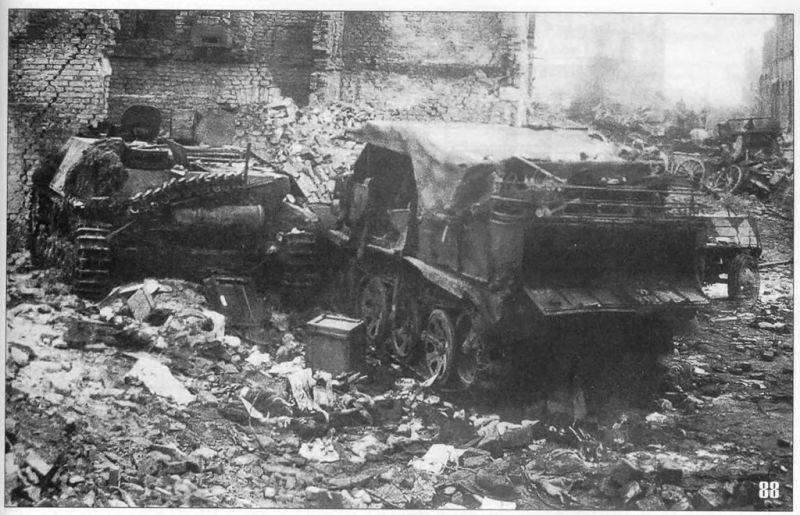
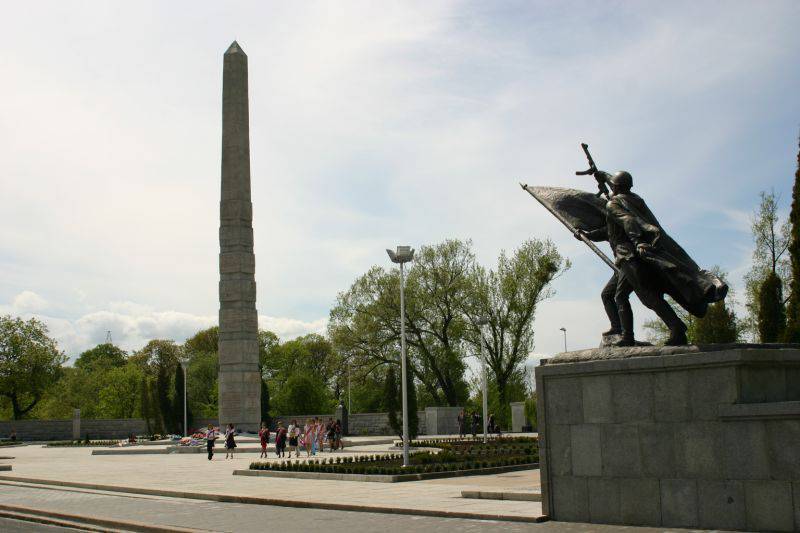
Information